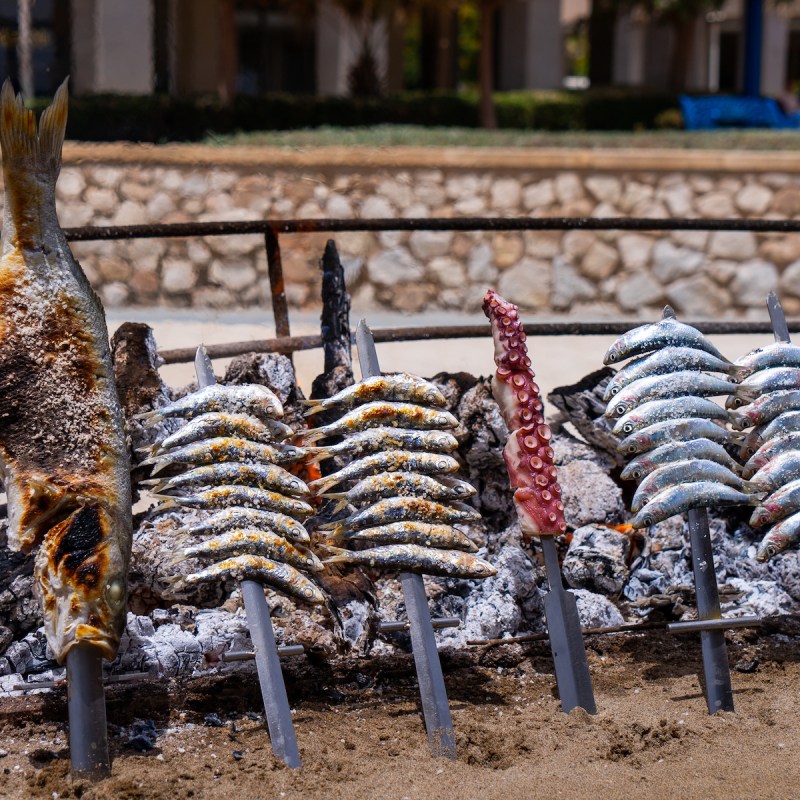
One of the best reasons I travel to Spain, other than the exquisite scenic beauty and magnificent architecture, is the food. My palate waters for the freshly caught seafood, acorn-fed ham, sun-kissed produce, and bountiful vineyard harvests. The Mediterranean flavors are lively and layered without being overly spicy, a hallmark of the country’s rich gastronomic heritage.
Videos by TravelAwaits
I’ve been fortunate to eat and drink my way through numerous cities and towns in Spain as a personal traveler and once on a media trip. Here’s my list, in no particular order, of must-try foods for both newcomers and repeat travelers.
Pro Tip: Keep in mind that Spain is a large, diverse country, so you’ll find regional specialties and exceptions. Some of my recommendations may not be available everywhere, but I’ve tried to hit the highlights.

1. Tapas And Pintxos
First, a few words about Spain’s iconic tapas and its culinary cousin, pintxos (sometimes spelled and always pronounced as “pinchos”). These are not the names of specific dishes, but rather, categories of edibles. Tapas and pintxos rate #1 on my list of favorites.
Tapas are small servings of a single food item, perhaps a dish of olives or a plate of cheese or meat. They are considered ideal for snacking along with a beverage. If you order several, you can make a hearty meal. You can also order larger servings to share with a group. Several of my must-try foods in this article are typically listed on tapas menus.
Origin stories vary for the tapa, which translates to “lid,” but the most common is that bartenders and wait staffers of yore started it by covering a patron’s glass with a complimentary slab of bread. (Some claim it was to keep the flies out.) The custom expanded over the years into heartier dishes. I recently spotted a tavern in Málaga’s city center with a sandwich board sign advertising five assorted tapas for 18 euros.
Pintxos, which are wildly popular in the Basque region, are finger foods that can be consumed in just a few bites. You’ll find little sandwiches, skewers, tartlets, and spreads of meat or cheese on a baguette slice. They are often speared with a toothpick. I had a pintxo craving during a recent stay in Málaga on the Costa del Sol, so I dropped into La Taberna del Pintxo. The cold pintxos are self-served, so I fixed myself a plate that included curried chicken salad and a crab tartlet. Paired with a chilled glass of white wine, it was the perfect end to a long day of sightseeing!

2. Jamón Ibérico (“Iberian Ham”)
One of Spain’s longest-held culinary traditions is cured ham, a savory reddish-pink meat marbled with silky white fat. As a tapa, it is presented in paper-thin slices artfully arranged on a plate. In many restaurants, bars, and specialty shops, you are likely to see one or more pork legs, with hooves intact, held in a vice. You can watch expert carvers with serious knives prepare each plate with precision.
Jamón Ibérico is widely considered the most prestigious of cured hams. It’s a tightly controlled designation awarded on such restrictions as geographic location, breed of pig, and its diet. The highest designation, “Jamón Ibérico de Bellota,” means the animals were acorn-fed for added flavor.

3. Paella Valenciana
Contrary to popular belief that paella is the signature dish of Spain, you won’t find it in every region of the country. When you do, chances are, it’s not authentic paella. For the real dead, you must go to Valencia, where it was created.
The Valencian version, like at Restaurante Palace Fesol — which has been making it for over a century — combines chicken, rabbit, snails, and tomatoes. Saffron provides the golden color and distinctive taste. Paella is cooked in a shallow pan over a fire, a method that forms a crusty bottom layer. It’s called socarrat and it’s delicious.
Fun Fact: September 20 is World Paella Day.

4. Fish And Seafood
With more than 3,000 miles of coastline, Spain is rich in culinary treasures from the sea. Atun, or “tuna,” is one of the most versatile. It is found as a salad garnish, tartare, main course, and in stews, to name a few uses. Prawns, scallops, clams, and mussels dominate many menus, while platters of fried anchovies and calamari are tapas staples.
On the sandy beaches of Costa del Sol, espetos are skewers of sardines or other fish that are grilled over wood-burning fires. Drizzle them with olive oil and lemon juice.

5. Ajo Blanco (“Almond Gazpacho Soup”)
Typical of southern Spain, ajo blanco is a chilled, creamy white soup. The main ingredients are crushed almonds (preferably Marcona), garlic, and olive oil. Some recipes include bread for thickening or sherry vinegar for a bit of tang. Garnishes may include grapes or other fruity bits and a drizzle of olive oil.
6. Gazpacho
Typical of Andalusia but widely available, especially in summer, gazpacho is a smooth cold soup brimming with garden goodness. The most essential ingredients are tomatoes and olive oil, but some recipes call for cucumbers or peppers. Garnishes may include diced onions and tomatoes, micro-greens, or croutons.

7. Ensaladilla Rusa (“Russian Potato Salad”)
Most everywhere in the country, you’ll find Russian potato salad. In some circles, it will be called “Spanish potato salad.” Ensaladilla translates to “little salad” and you’ll find it everywhere, from casual sidewalk cafés to upscale white-tablecloth restaurants.
Basically, it is an ultra-creamy concoction of diced boiled potatoes, peas, carrots, tuna, and mayonnaise. Other ingredients that may be added are red peppers, pimentos, olives, and egg. Higher-end establishments often elevate the dish even further. At Kaleido Málaga Port overlooking the harbor, my Russian salad was topped with prawns, micro-greens, and dollops of black caviar.
Fun Fact: In Russia, the same concoction is called an Olivier salad after the chef who is said to have invented it.

8. Croquetas (“Croquettes”)
A mainstay on tapas menus, croquetas are deep-fried nuggets with a creamy bechamel filling. The most traditional variation contains bits of cured ham, but others are made with mushrooms, spinach, cheese, fish, or chicken. Croquetas come in different shapes and occasional garnishes. Some are round like donut holes and others are tubular like a cocktail weenie. Just pop one in your mouth and you’ll be reaching for more.
9. Patatas (“Potatoes”)
Spain has so many delicious variations of potatoes, they are impossible for me to resist. Patatas bravas, or “brave potatoes,” are a tapas classic. Potatoes are cubed and fried in olive oil and accompanied by a zesty red sauce. Patatas alioli are the same but served with a white garlic sauce. Patatas fritas, or “fried potatoes,” are the Spanish equivalent of French fries, only better.
Another great take, tortilla de patatas, also known as a Spanish or potato omelet, is similar to a quiche. Made with eggs and diced potatoes, and sometimes onions, it’s both a breakfast dish and a tapa.

10. Churros
Churros are a yummy fried-dough finger food perfect for breakfast or between-meal snacking. Shaped into rods or loops with a ribbed exterior, they are crisp on the outside and soft on the inside. Spanish churros are unadorned, unlike Mexican versions that come dredged in sugar and cinnamon. Dust yours with sugar, if you like. Better yet, order churros con chocolate and you’ll get a cup of warm, thick chocolate for dunking.
11. House Wine
One of the largest and most prestigious wine-producing countries in the world, Spain is well-known for robust reds from La Rioja, fortified sherries from Andalusia, and sparkling cava from Catalonia. But here’s the thing to remember: In mainstream Spanish culture, wine is a normal part of everyday life and dining, rather than a celebratory indulgence like it might be elsewhere. Every bar and restaurant carries its own vino de casa (“house wine”), which is sure to be good because they sell a lot of it. House wine is also inexpensive. A glass is likely to cost you less than a Coca-Cola. Make mine a vino blanco, please!
Related Reading:
